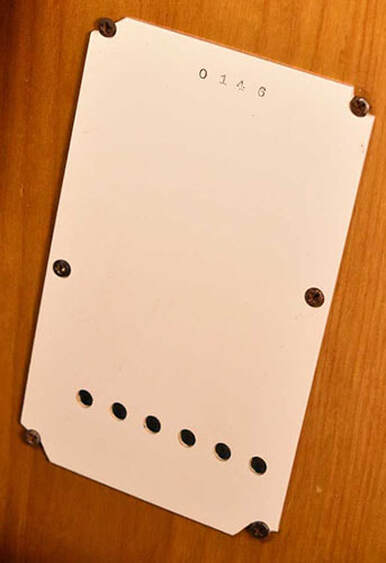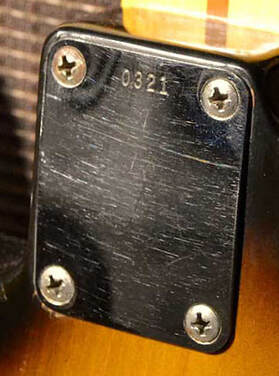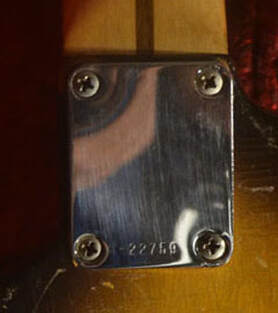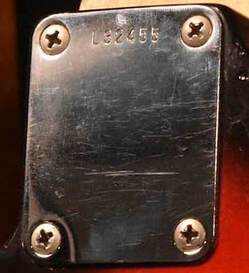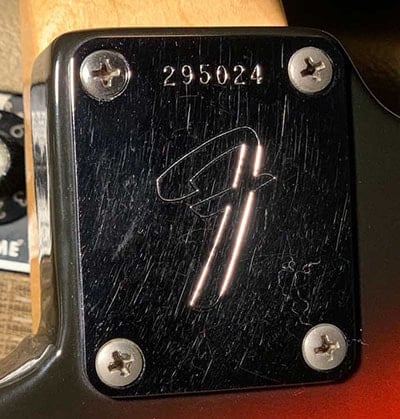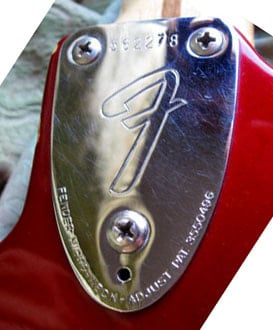THE FIRST SERIAL NUMBERS
|
The first Stratocasters featured a four-digit serial number in the 0100’s and early 0200’s stamped on the plastic vibrato back plate. It’s interesting to note that the last digit wasn't perfectly in line with the first three digits and sometimes is even slightly set apart.
At this time Leo Fender decided to merge the serial numbers of its solid body instruments (Telecaster, Esquire, Precision Bass, and Stratocaster), which until that moment had distinct numbers, in a single numbering line, and to move them to neck plate - until 1954 Telecaster and Precision Bass featured their serial number stamped on their bridge plate. Therefore, after the first batch of Fender Stratocaster received its serial number on the back plate, new serialized neck plates were manufactured. It’s important to keep in mind that the serial number stamped on the neck plate could be lower than 0100, but these guitars usually had a neck dated June or July, like David Gilmour’s 0001 Stratocaster, that is not the oldest one (date on the neck June 1954, date on the body 28 September 1954), although it is one of the first Stratocasters fabricated. |
|
Furthermore, the assignment of serial numbers did not occur according to a predetermined sequence - both back and neck plates were stored on shelves or in bins and might have been fabricated many months before assembly - and legit Fender Stratocasters older than the famous “0100” guitar that featured the serial number on the neck plate are known to exist. Indeed, the 0100 Stratocaster, neck date 1-54 and body date 4-54, was not the first Stratocaster made, as often reported. But, probably, it was the first “production guitar”, whilst earlier Stratocasters might have been salesman samples, which were sold to the dealers. Certain aspects of these early 1954 “pre-production” Stratocasters looked primitive, almost handmade compared with later versions, and some of these early strats featured re-routed bodies from the first batch of Stratocaster prototypes made in 1953.
|
The 4-digit serial numbers were used up until the early 1200’s, albeit without strict sequential order, in December 1954. Given the Stratocasters made in 1954 known today, it appears really unlikely that 1200 units were made!
In December 1954, Fender merged the serial numbers of its solid body instruments (Telecaster, Esquire, Precision Bass and Stratocaster), which until that moment had distinct numbers, in a single numbering line. Thus, Stratocaster serial number jumped about 5000 numbers ahead and the last 1954 Stratocasters reached the 6000’s.
By the end of 1955, a “0” was added in front of the 4-digit of the 8000’s. Hence, Stratocaster serial number became 5-digit.
By the end of 1955, a “0” was added in front of the 4-digit of the 8000’s. Hence, Stratocaster serial number became 5-digit.
FIRST SERIAL NUMBERS ODDITIES
|
THE "L" SERIES
|
Although legends say that the letter “L” preceding the numeration of the serials appeared on the Stratocasters made between the end of 1962 and mid 1965 represented a tribute to Leo Fender, actually it looks like it was a simple stamping mistake.
These serial numbers were included between "L00001" and the L90000s’, without any strict correlation in time. Despite these serial numbers are found on Stratocasters dated up to mid-1965, a few L-Series numbers were rarely used until early 1966 Stratocasters. |
THE "F" SERIES
When the “L” Series reached the 90000’s, after the CBS takeover in 1965, serial numbers went from five to six digits, starting from 100000, but without the “L” prefix. The new neck plates were stamped with a large “F” letter, typical of the CBS Stratocasters, hence the F-Series nickname.
Despite these neck plates appeared in mid 1965, until the beginning of 1965 they overlapped with the L-Series, in order to finish all the neck plates in stock.
Due to a drastically increased production after mid-1965, the serial numbers ran from 100,000’s to 700,000’s in just eleven years.
Despite these neck plates appeared in mid 1965, until the beginning of 1965 they overlapped with the L-Series, in order to finish all the neck plates in stock.
Due to a drastically increased production after mid-1965, the serial numbers ran from 100,000’s to 700,000’s in just eleven years.
SERIAL NUMBERS ON THE HEADSTOCK
In late 1976 Fender stopped stamping the serial number on the neck plate and began to incorporate it into the headstock decals. A new 7-digit code was adopted, with a 2-digit prefix indicating the year plus five numbers identifying the guitar.
In the late '70s the serial number was also printed on a sticker placed into the body pickups cavities, underneath the pickguard and into the neck pocket.
At first, the serial number had a simple “76” prefix in bold numerals, which in a few months was replaced by “S6”, with “S” standing for “seventies”.
Later, other letters were used to identify the decades: “E” in the 1980s, “N” in the 1990s and “Z” in the 2000s.
Until 2010, the American Deluxe and the Signature guitars follows the same serialization scheme, but their serial numbers were preceded respectively by “D” and “S” letters. In 2010, Fender decided to merge their serial numbers with that of the American Standard Stratocaster. Thus, since 2010, Fender Stratocaster serial numbers had the simple “US” prefix followed by the last two digits of the year (e.g. “US12” for 2012) in bold.
This scheme, clear and simple, actually is not a reliable method to date a Stratocaster. In fact, at the beginning of a new year the old decals were not instantly discarded and continued to be used into the new year. Usually new decals were applied only after some months - ca. 3 months for the US Stratocasters and ca. 4, 5 or 6 months for the Mexican Stratocasters.
Moreover, there are other exceptions to this scheme that must be considered.
In the late '70s the serial number was also printed on a sticker placed into the body pickups cavities, underneath the pickguard and into the neck pocket.
At first, the serial number had a simple “76” prefix in bold numerals, which in a few months was replaced by “S6”, with “S” standing for “seventies”.
Later, other letters were used to identify the decades: “E” in the 1980s, “N” in the 1990s and “Z” in the 2000s.
Until 2010, the American Deluxe and the Signature guitars follows the same serialization scheme, but their serial numbers were preceded respectively by “D” and “S” letters. In 2010, Fender decided to merge their serial numbers with that of the American Standard Stratocaster. Thus, since 2010, Fender Stratocaster serial numbers had the simple “US” prefix followed by the last two digits of the year (e.g. “US12” for 2012) in bold.
This scheme, clear and simple, actually is not a reliable method to date a Stratocaster. In fact, at the beginning of a new year the old decals were not instantly discarded and continued to be used into the new year. Usually new decals were applied only after some months - ca. 3 months for the US Stratocasters and ca. 4, 5 or 6 months for the Mexican Stratocasters.
Moreover, there are other exceptions to this scheme that must be considered.
EXCEPTIONS
- Many 1980 and 1981 guitars were made with the “S9” prefix instead of “E0” or “E1” (in which “E” stands for “eighties”).
- In 1984, most of the Fender Stratocasters manufactured still featured the “E3” serial number.
- After the 1985 buyout, the “E4” prefix was used until 1988, because the new FMIC had a sizeable inventory of old decals. Thus, “E5”, “E6” and “E7” were never used. Vintage Reissues were the only notable exception to this rule (look down the page). A few “E3” serial numbers were also used in 1986.
- At the beginning of 1990, when Fender was still using the old “E9” decals, the new ones were ordered. But, “N9” decals were ordered by mistake instead of “N0”! Wrong decals were used for a time before correct “N0” serial numbers were finally order. Thus, both “N0” and “N9” were used on 1990 American Standard and Plus Stratocasters. But it’s easy to distinguish between a 1990 “N9” and one of 1999 due to the date applied on the neck of the Stratocaster. These inconsistences can be easily spotted because in 1995 Fender moved the serial number of the American Standard and Plus guitars from the front to the back face of the headstock and, at the same time, replaced the Modern logo with a whitish Spaghetti logo. Consequently a 1999 “N9” Stratocaster will have the whitish Spaghetti Logo on the front of the headstock and the serial number on the back, whilst a 1990 or 1991 “N9” will have both serial number and Modern Logo on the front. Any doubts?
- In 2010, Fender started to use “US” followed by the last two digits of the year. However, in the first three months of 2010, an all numerals 8-digit serial number was used, with the “10” prefix in normal font, followed by six digits.
Special Series and other prefixes
VINTAGE SERIES/AMERICAN VINTAGE/AMERICAN ORIGINAL SERIES
The Vintage Stratocasters, unveiled in 1982, featured the serial number stamped on the neck plate starting with “V” and without any correlation with the year of production.
By the mid- 2012 Fender began to indicate the year of the issue: “V12” for the American Vintage Strats made in 2012, “V13” for those made in 2013, and so on.
Since 2018, the “V” prefix was used for the American Original Stratocasters.
Further information about their serial number can be found here.
By the mid- 2012 Fender began to indicate the year of the issue: “V12” for the American Vintage Strats made in 2012, “V13” for those made in 2013, and so on.
Since 2018, the “V” prefix was used for the American Original Stratocasters.
Further information about their serial number can be found here.
SIGNATURE SERIES
Until 2009 the Signature series followed the same rule of the American Standard series, but their serial number was preceded by the letter “S” (e.g. SN5xxxxx for 1995).
But in the late '80s, Fender ordered a large batch of the “SE” decals. It was likely a mistake. Thus, they used them - and continued using them well into 1993. When the “SE9” prefix decals were used up, in about 1994, Fender started using "SN" serial numbers.
In 2010, Fender merged the serial numbers of all its guitars, with the exception of the American Vintage Series and the instruments made by Custom Shop. Therefore, Signature models followed the same serialization scheme of the American Standard guitars (US10xxxxxx, US11xxxxxx, etc.), without the “S” prefix.
But in the late '80s, Fender ordered a large batch of the “SE” decals. It was likely a mistake. Thus, they used them - and continued using them well into 1993. When the “SE9” prefix decals were used up, in about 1994, Fender started using "SN" serial numbers.
In 2010, Fender merged the serial numbers of all its guitars, with the exception of the American Vintage Series and the instruments made by Custom Shop. Therefore, Signature models followed the same serialization scheme of the American Standard guitars (US10xxxxxx, US11xxxxxx, etc.), without the “S” prefix.
AMERICAN DELUXE SERIES
The American Deluxe Stratocasters, on the market since the late '90s, had a serial number that followed the same rule of the Signature Strats, with the difference that it did not start with the letter “S”, but with the letter “D”. Therefore, the prefixes had been DN8, DN9, DZ0, DZ1, DZ2, etc., up to DZ9. Since 2010 also the serial numbers of the American Deluxe Series adapted to the "universal" one of the Stratocasters made in USA with the prefix "US".
OTHER PREFIXES INDEPENDENT OF THE YEAR OF PRODUCTION
G: The Strat
CA: Gold Stratocaster
CC: Walnut Strat
GO: Gold Strat
AMXN: California Series
R: Time Machine and Relics Series, stamped on the neck plate
CS, CN, CZ: Custom Classic, Classic Player and other Custom Shop guitars, stamped on the neck plate
TN7: Voodoo Stratocaster and '68 Reverse Strat Special
FN2: Floyd Rose Classic Stratocaster and the first Floyd Rose Classic HH (and HSS) Stratocaster (ca. 1992-1998)
EE: American Standard Stratocaster made in 1987/1988
I, K, H, F, G: Stratocaster sold as made in USA between 1989 and 1990, probably made with Mexican body and neck, and Far East electronics and hardware. They featured the words "MADE IN USA" embossed stamp at the base of the neck
CA: Gold Stratocaster
CC: Walnut Strat
GO: Gold Strat
AMXN: California Series
R: Time Machine and Relics Series, stamped on the neck plate
CS, CN, CZ: Custom Classic, Classic Player and other Custom Shop guitars, stamped on the neck plate
TN7: Voodoo Stratocaster and '68 Reverse Strat Special
FN2: Floyd Rose Classic Stratocaster and the first Floyd Rose Classic HH (and HSS) Stratocaster (ca. 1992-1998)
EE: American Standard Stratocaster made in 1987/1988
I, K, H, F, G: Stratocaster sold as made in USA between 1989 and 1990, probably made with Mexican body and neck, and Far East electronics and hardware. They featured the words "MADE IN USA" embossed stamp at the base of the neck
SERIAL NUMBERS, MADE IN THE USA GUITARS
If you are interested in serial numbers of guitars made in other Countries, click here
|
1954
|
Under 1300
A few in the 6000s |
|
1955
|
4 digits between the 6000s e 8000s
5 digits under 10000 (beginning with "0") A few 5 digits in the first half of 10000s |
|
1956
|
A few 4 digits over the 6000s
A few 5 digits under 10000 (beginning with "0") 5 digits in the high 16000s |
|
1957
|
A few 5 digits in the mid of the 10000s
5 digits between second half of 17000s and the first half of 20000s (many beginning with "-") |
|
1958
|
A few 5 digits in the 20000s (many beginning with "-")
6 digits in the 020000s (beginning with "0") 5 digits in the high 20000s and the low 30000s |
|
1959
|
5 digits in the 30000s and the low 40000s
|
|
1960
|
5 digits in the 40000s and 50000s
|
|
1961
|
5 digits in the 50000s and 60000s
5 digits in the low 70000s |
|
1962
|
5 digits in the 60000s, 70000s and 80000s
A few in the first half of the 90000s |
|
1963
|
5 digits between the 80000s and the 90000s
Between L0xxxx and L20000s A few in the low L20000s |
|
1964
|
In the L20000s, L30000s, L40000s and L50000s
|
|
1965
|
In the L50000s, L60000s, L70000s, L80000s e L90000s
6 digits in the low 100000s |
|
1966
|
6 digits in the 100000s and the low 200000s
|
|
1967
|
6 digits in the high 100000s and the first half of 200000s
|
|
1968
|
6 digits in the 200000s
|
|
1969
|
6 digits in the second half of 200000s
A few 6 digits on the low 300000s |
|
1970
|
6 digits in the high 200000s and the low 300000s
|
|
1971
|
6 digits in the first half of 300000s
|
|
1972
|
6 digits in the 300000s
|
|
1973
|
6 digits in the high 300000s, in the 400000s and the low 500000s
|
|
1974
|
6 digits in the high 400000s, in the 500000s and the low 600000s
|
|
1975
|
6 digits in the high 400000s, in the 500000s and 600000s
|
|
1976
|
6 digits in the high 500000s, in the 600000s and in the low 700000s
A few 76 + 5 digits A few S6 + 5 digits |
|
1977
|
S7 + 5 digits
A few S8 + 5 digits |
|
1978
|
S8 + 5 digits
A few S7 + 5 digits or S9 + 5 digits |
|
1979
|
S9 + 5 digits
|
|
1980
|
S9 or E0 + 5 digits
A few E1 + 5 digits |
|
1981
|
E1 + 5 digits
A few S9 and E0 + 5 digits A few Bullet had an all-numeral serial number "1" + 5 digits |
|
1982
|
E2 + 5 digits
A few E1 and E3 + 5 digits |
|
1983
|
E3 + 5 digits
A few E2 + 5 digits E1 + 5 digits (Bullet only) |
|
1984
|
E3 + 5 digits
Maybe a few E4 + 5 digits |
|
1985
|
Only a few Vintage Reissues were manufactured
|
|
1986
|
Corona factory produced only Vintage reissues and the first American Standard Strats had a serial number that started with "E3" or "E4" (rare)
|
|
1987
|
E4 + 5 digits
|
|
1988
|
E4 or E8 + 5 digits
|
|
1989
|
E9 + 5 digits
A few E8 + 5 digits |
|
1990
|
E9 or N0 + 5 digits
A few N9 + 5 digits |
|
1991
|
N1 + 5 or 6 digits
A few N0 + 5 digits |
|
1992
|
N2 + 5 or 6 digits
A few N1 + 5 or 6 digits |
|
1993
|
N3 + 5 or 6 digits
A few N2 + 5 or 6 digits |
|
1994
|
N4 + 5 or 6 cifre
A few N3 + 5 or 6 digits |
|
1995
|
N5 + 5 or 6 digits
A few N4 + 5 or 6 digits |
|
1996
|
N6 + 5 or 6 digits
A few N5 + 5 or 6 digits |
|
1997
|
N7 + 5 or 6 digits
A few N6 + 5 or 6 digits |
|
1998
|
N8 + 5 or 6 digits
A few N7 + 5 or 6 digits |
|
1999
|
N9 + 5 or 6 digits
A few N8 + 5 or 6 digits |
|
2000
|
Z0 + 5 or 6 digits
A few N9 + 5 or 6 digits |
|
2001
|
Z1 + 5 or 6 digits
A few Z0 + 5 or 6 digits |
|
2002
|
Z2 + 5 or 6 cifre
A few Z1 + 5 or 6 digits |
|
2003
|
Z3+ 5 or 6 digits
A few Z2 + 5 or 6 digits |
|
2004
|
Z4 + 5 or 6 digits
A few Z3 + 5 o 6 digits |
|
2005
|
Z5 + 5 or 6 digits
A few Z4 + 5 or 6 digits |
|
2006
|
Z6 + 5 or 6 digits
A few Z5 + 5 or 6 digits |
|
2007
|
Z7 + 5 or 6 digits
A few Z6 + 5 or 6 digits |
|
2008
|
Z8 + 5 or 6 digits
A few Z7 + 5 or 6 digits |
|
2009
|
Z9 + 5 or 6 digits
A few Z8 + 5 or 6 digits A few 10000000s |
|
2010
|
US10 + 6 digits
A few Z9 + 5 or 6 digits A few 10000000s |
|
2011
|
US11 + 6 digits
A few US10 + 6 digits |
|
2012
|
US12 + 6 digits
A few US11 + 6 digits |
|
2013
|
US13 + 6 digits
A few US12 + 6 digits |
|
2014
|
US14 + 6 digits
A few US13 + 6 digits |
|
2015
|
US15 + 6 digits
A few US14 + 6 digits |
|
2016
|
US16 + 6 digits
A few US15 + 6 digits |
|
2017
|
US17 + 6 digits
A few US16 + 6 digits |
|
2018
|
US18 + 6 digits
A few US17 + 6 digits |
|
2019
|
US19 + 6 digits
A few US18 + 6 digits |




